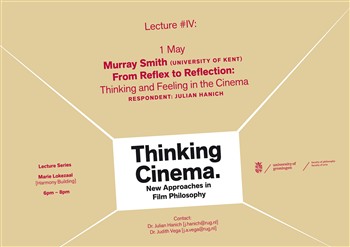From Reflex to Reflection: Thinking and Feeling in the Cinema

Lecture by Murray Smith (University of Kent). Respondent: Julian Hanich (University of Groningen)
This is the fourth episode of the lecture series Thinking Cinema: New Approaches in Film Philosophy
Abstract
Like persons, works of art are a great deal richer than philosophy can or should want to capture. Arthur Danto, Encounters and Reflections
Recent debates around the idea of ‘film as philosophy’ – filmmaking as a vehicle rather than an object of philosophical activity – stress the ability of film to engage us cognitively at a very sophisticated level; in these debates, the word ‘philosophy’ functions first and foremost to bring into play a notion of high-level cognition. In this paper I seek to contextualize these debates, and the claim that films can in some sense ‘do’ philosophy, in two ways.
First, I consider the variety of senses in which the notion of philosophy might be deployed, underlining the exceptionally demanding standards of rational warrant, empirical support, and reflective certainty that ‘philosophy,’ on at least one major modern conception, requires. Are films of any type or tradition aptly understood as philosophical in this sense? Probably not. But all is not lost; a second context might prove more fruitful in grasping sympathetically the idea that a film might be philosophical in some sense. This context is the debate concerning the varieties of value – aesthetic, ethical, cognitive, art-historical, and so forth – that artworks may possess. In this context, we can treat the ‘film as philosophy’ claim as an ambitious version of arguments concerning the cognitive value of artworks – the ability of artworks, that is, to enhance our knowledge of the world. This context also enables us to see what is often lost or overlooked in such arguments.
Artworks, not least filmic artworks, engage and have value for us on many levels – sensuously, perceptually, and emotionally, as well as cognitively – levels which, moreover, interact with one another as we watch and reflect upon them. While recognizing the cognitive (and even philosophical) value that films may possess, it is critical that the multifaceted nature of film spectatorship is kept in view, and that we avoid any simple hierarchy among the levels of response and types of value at play within our experience of film. In exploring these issues, I draw on a variety of examples, focusing on Blade Runner as a central case study.
About
Murray Smith is Professor of Film Studies at the University of Kent, Canterbury, UK, co-director of the Aesthetics Research Centre at Kent, and President of the Society for Cognitive Studies of the Moving Image . His publications include Engaging Characters: Fiction, Emotion, and the Cinema, Film Theory and Philosophy (co-edited with Richard Allen), and Thinking through Cinema (co-edited with Tom Wartenberg). He is currently at work on Film, Art, and the Third Culture (forthcoming with OUP).
When & Where?
Faculty of Arts, Harmony building, Oude Kijk in’t Jatstraat 26, Marie Lokezaal
Thursday, 1 May, 6-8 PM
| Last modified: | 17 September 2020 5.26 p.m. |
